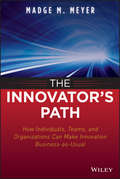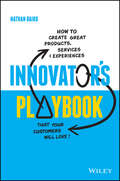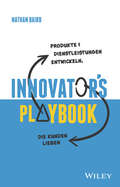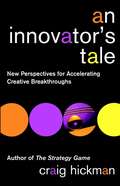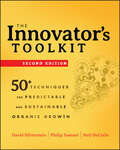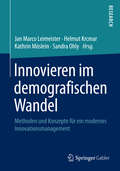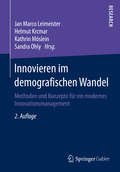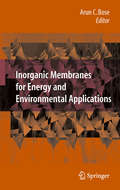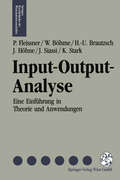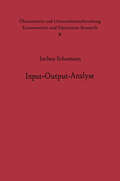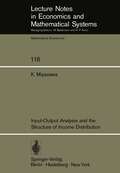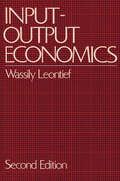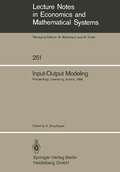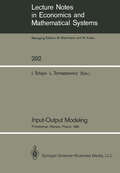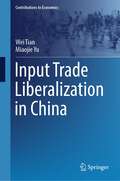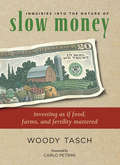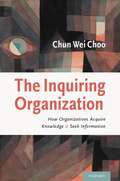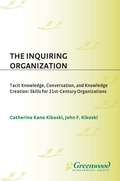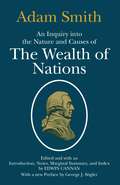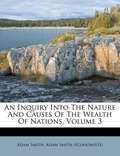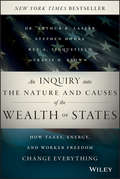- Table View
- List View
The Innovator's Path: How Individuals, Teams, and Organizations Can Make Innovation Business-as-Usual
by Madge M. MeyerA guide to creating and sustaining a culture of innovation focused on business value The Innovator’s Path introduces business readers to thought leader Madge M. Meyer’s unique, cross-cultural perspective on corporate innovation. The book presents eight essential disciplines (Listen, Lead, Position, Promote, Connect, Commit, Execute, and Evolve) that pave the way for individuals, teams, and organizations to continually innovate in ways that create new business value. The author overturns existing assumptions about inspiring and managing innovation, while offering new insights and practical advice for aspiring innovators and corporate leaders. Meyer demonstrates her points by telling the stories behind many of her award-winning results and adds engaging personal anecdotes to illustrate many of her points. The book also contains contributions from an extraordinary and diverse set of industry innovators. Offers new ways for cultivating a mindset and culture of results-focused innovation and business value creation Equips CEOs, CFOs, CIOs, CMOs, COOs, CTOs and aspiring innovators with proven principles and practices for leading innovation Focuses her readers' attention on the eight essential disciplines that help individuals, teams, and organizations innovate more successfully Whether your focus is on your career, your team's success, or your organization's future, The Innovator’s Path provides you with the insights, strategies, techniques, and inspiration you need to accelerate your innovation progress.
Innovator's Playbook: How to Create Great Products, Services and Experiences that Your Customers Will Love
by Nathan BairdTake a Design-led Approach to Innovation Innovation drives growth in organisations and entire economies. Yet innovation is hard, risky and rarely successful. Most innovations and startups fail because of a lack of focus on the front end of the innovation process where customer needs are researched, insights are distilled, solutions are ideated, prototyped and tested and business models are shaped. But innovation doesn’t have to be this way. In Innovator’s Playbook, author and leading Design Thinking expert Nathan Baird shares his 20 years of hands-on experience, tools and methods for developing a winning customer-centric approach to innovation. This book will teach you how to apply the design thinking method to innovation and help you to innovate better with five practical and proven stages: 1. Build the right team for innovation. 2. Better understand your customer through empathy. 3. Distill and refine customer-centric needs and insights. 4. Unleash your team’s creativity to create fresh new ideas to address customer needs. 5. Experiment and validate desirable, feasible and viable solutions. Innovator’s Playbook helps entrepreneurs, corporate teams, startups and leaders across all levels to use design-led methodologies for start-to-finish innovation success.
Innovator's Playbook: How to Create Great Products, Services and Experiences that Your Customers Will Love
by Nathan BairdTake a Design-led Approach to Innovation Innovation drives growth in organisations and entire economies. Yet innovation is hard, risky and rarely successful. Most innovations and startups fail because of a lack of focus on the front end of the innovation process where customer needs are researched, insights are distilled, solutions are ideated, prototyped and tested and business models are shaped. But innovation doesn’t have to be this way. In Innovator’s Playbook, author and leading Design Thinking expert Nathan Baird shares his 20 years of hands-on experience, tools and methods for developing a winning customer-centric approach to innovation. This book will teach you how to apply the design thinking method to innovation and help you to innovate better with five practical and proven stages: 1. Build the right team for innovation. 2. Better understand your customer through empathy. 3. Distill and refine customer-centric needs and insights. 4. Unleash your team’s creativity to create fresh new ideas to address customer needs. 5. Experiment and validate desirable, feasible and viable solutions. Innovator’s Playbook helps entrepreneurs, corporate teams, startups and leaders across all levels to use design-led methodologies for start-to-finish innovation success.
Innovator's Playbook: Produkte und Dienstleistungen entwickeln, die Kunden lieben
by Nathan BairdInnovation treibt das Wachstum von Organisationen und ganzen Volkswirtschaften an. Doch Innovation ist hart, riskant und selten erfolgreich. Die meisten Innovationen und Neugründungen scheitern an der mangelnden Konzentration auf das Front-End des Innovationsprozesses, wo Kundenbedürfnisse erforscht, Erkenntnisse destilliert, Lösungen entworfen, Prototypen erstellt und getestet und Geschäftsmodelle gestaltet werden. Aber Innovation muss nicht auf diese Weise erfolgen. In "Innovator's Playbook" teilt der Autor und führende Design-Thinking-Experte Nathan Baird seine 20 Jahre praktische Erfahrung. Er stellt Werkzeuge und Methoden vor, die er in Hunderten von erfolgreichen Implementierungen von kundenzentrierter Innovation und kundenzentriertem Design in verschiedenen Branchen und Kontinenten entwickelt hat. Ziel ist die Entwicklung eines erfolgreichen kundenorientierten Innovationsansatzes. In diesem Buch lernen Sie, wie Sie die Design-Thinking-Methode auf Innovation anwenden können. Es hilft Ihnen, in fünf praktischen und bewährten Phasen besser zu innovieren: 1. Stellen Sie das richtige Team für Innovation zusammen. 2. Verstehen Sie Ihren Kunden durch Einfühlungsvermögen besser. 3. Destillieren und verfeinern Sie kundenzentrierte Bedürfnisse und Erkenntnisse. 4. Setzen Sie die Kreativität Ihres Teams frei, um frische neue Ideen zu entwickeln und um Kundenbedürfnisse anzusprechen. 5. Erprobung und Validierung wünschenswerter, durchführbarer und tragfähiger Lösungen. "Innovator's Playbook" hilft Unternehmern, Unternehmensteams, Start-ups und Führungskräften auf allen Ebenen, designorientierte Methoden für den Innovationserfolg von Anfang bis Ende einzusetzen.
An Innovator's Tale: New Perspectives for Accelerating Creative Breakthroughs
by Craig HickmanA compelling novel of business intrigue, suspense, and transformation from a critically acclaimed author In an exciting departure from his writing on leadership, corporate culture, and strategic change, Craig Hickman, the author of such titles as Creating Excellence and Mind of a Manager, Soul of a Leader, gives us a compelling tale of corporate intrigue and innovation. A suspenseful business novel that engages the reader on every dramatic level while teaching important lessons on how to be a more effective innovator and creative problem-solver, An Innovator's Tale focuses on the trials and tribulations of a newly promoted vice president who has been thrust into a world of corporate turnaround, duplicity, and espionage. Readers learn by her example as she discovers and applies four different levels and five critical stages of innovation, while struggling to contain containing the damage done by stolen business secrets, computer hacking, and high-level company officers who are not quite what they seem to be.
The Innovator's Toolkit: 50+ Techniques for Predictable and Sustainable Organic Growth
by David Silverstein Philip Samuel Neil DeCarloA compendium of tools and techniques that every innovator needs The Innovator's Toolkit is an essential companion for every innovator, innovation team leader, operations manager, and corporate change agent who needs to drive organic growth. Written and presented in an easy-to-use reference format, the book helps users understand why, when, and how to apply each technique for maximum benefits and results. The fifty-plus tools and techniques in this book are organized around a framework for identifying innovation opportunities, generating new and unusual ideas, selecting the best ideas for further refinement, and implementing new solutions that better meet customer expectations. This revised second edition includes significant updates to nearly two dozen techniques Also offers several brand new techniques, including Idea Harvesting and Treatment, Seventy-six Standard Solutions, and Six Thinking Hats This updated and revised edition of The Innovator's Toolkit simply helps innovation leaders, managers, and specialists do their jobs better than ever before—giving them more confidence, greatly reducing the chance of expensive failures, and packing more practical innovation knowhow under one cover than ever before.
The Innovator's Toolkit: 50+ Techniques for Predictable and Sustainable Organic Growth
by David Silverstein Philip Samuel Neil DeCarloA compendium of tools and techniques that every innovator needs The Innovator's Toolkit is an essential companion for every innovator, innovation team leader, operations manager, and corporate change agent who needs to drive organic growth. Written and presented in an easy-to-use reference format, the book helps users understand why, when, and how to apply each technique for maximum benefits and results. The fifty-plus tools and techniques in this book are organized around a framework for identifying innovation opportunities, generating new and unusual ideas, selecting the best ideas for further refinement, and implementing new solutions that better meet customer expectations. This revised second edition includes significant updates to nearly two dozen techniques Also offers several brand new techniques, including Idea Harvesting and Treatment, Seventy-six Standard Solutions, and Six Thinking Hats This updated and revised edition of The Innovator's Toolkit simply helps innovation leaders, managers, and specialists do their jobs better than ever before—giving them more confidence, greatly reducing the chance of expensive failures, and packing more practical innovation knowhow under one cover than ever before.
Innovieren im demografischen Wandel: Methoden und Konzepte für ein modernes Innovationsmanagement
by Jan Marco Leimeister Helmut Krcmar Kathrin Möslein Sandra OhlyDie Autoren des vorliegenden Sammelbandes stellen neue Methoden und Konzepte vor, wie Unternehmen das Wissen jüngerer und älterer Mitarbeiter erfolgreich kombinieren und damit unter geänderten Rahmenbedingungen des demografischen Wandels erfolgreiche Innovationen generieren können. Innerhalb des Verbundprojektes TANDEM erfolgte die Initiierung altersdiverser Communities, die sich aus jungen und alten Mitarbeitern eines Unternehmens rekrutieren und gemeinsam Innovationen generieren, bewerten und im Rahmen gemeinsamer Entwicklungsprojekte umsetzen.
Innovieren im demografischen Wandel: Methoden und Konzepte für ein modernes Innovationsmanagement
Die Autoren des vorliegenden Sammelbandes stellen neue Methoden und Konzepte vor, wie Unternehmen das Wissen jüngerer und älterer Mitarbeiter erfolgreich kombinieren und damit unter geänderten Rahmenbedingungen des demografischen Wandels erfolgreiche Innovationen generieren können. Innerhalb des Verbundprojektes TANDEM erfolgte die Initiierung altersdiverser Communities, die sich aus jungen und alten Mitarbeitern eines Unternehmens rekrutieren und gemeinsam Innovationen generieren, bewerten und im Rahmen gemeinsamer Entwicklungsprojekte umsetzen. Die 2. Auflage wurde aktualisiert.
Inorganic Membranes for Energy and Environmental Applications
by Arun C. BoseResearch interest in inorganic membrane materials and processes has significantly increased in recent years due to novel, potentially low-cost energy and fuel production applications. This book documents the recent progress in membrane science, especially in advanced materials and novel reaction and separation concepts. The book classifies membranes based on the mechanism of operation, i.e., size exclusion filtration, solution-diffusion, and mixed ion-electron conduction of the permeate streams. This is the first book on the use of inorganic membranes for fuel and energy applications.
Input-Output-Analyse: Eine Einführung in Theorie und Anwendungen (Springers Kurzlehrbücher der Wirtschaftswissenschaften)
by Peter Fleissner Wolfgang Böhme Hans-Ulrich Brautzsch Jörg Höhne Jilla Siassi Karl StarkDie Input-Output-Analyse stellt ein unverzichtbares Instrument zur Untersuchung und Simulation wirtschaftlicher Beziehungen dar. Ihre Anwendung ist aber nicht auf ökonomische Fragen beschränkt. Immer häufiger wird sie zur Behandlung ökologischer und regionalpolitischer Probleme eingesetzt. Das vorliegende Werk führt zunächst Anfänger schrittweise in die Theorie und Methoden der Input-Output-Analyse ein. Der Einstieg in die Thematik erfolgt über das "klassische" statische Input-Output-Modell von Nobelpreisträger Wassily Leontief, wobei die aus der Betriebswirtschaftslehre stammende Kontendarstellung verallgemeinert wird. Die in der Thematik etwas erfahreneren Leser/-innen finden u.a. Probleme der Mehrfachklassifikation, Teil-Input-Output-Tabellen und Modelle mit variablen Koeffizienten. Nichtlineare und dynamische Modelle schließen den theoretischen Teil ab. In diesem Buch sind nicht nur die Standardverfahren westlicher Provenienz eingeflossen, sondern auch weitgehend unbekannte Ergebnisse von Forschungsarbeiten aus den ehemaligen sozialistischen Ländern.
Input-Output-Analyse (Ökonometrie und Unternehmensforschung Econometrics and Operations Research #10)
by J. SchumannInput-Output Analysis and the Structure of Income Distribution (Lecture Notes in Economics and Mathematical Systems #116)
by K. MiyazawaThe purpose of this study is in keeping with the shift in concern over the eco nomic problems of growth to those of income distribution in recent years. Income distribution problems may be analyzed by not only the traditional procedures, but also by some extensions of the input-output technique as I shall demonstrate in this volume of the Lecture Notes. Some fruitful results are obtained by applying the extended input-output technique to income analysis as well as to output analysis. This volume consists of three parts. These parts may be viewed along two veins, with some overlapping unavoidable: (1) Parts One and Two contain extensions of the input-output analysis and (2) Parts One and Three contain studies of the effects of the structure of income distribution on some other economic relationships. First, as an extension of the input-output analysis, we present a synthesis of the Leontief interindustry matrix multiplier and the Keynesian income multiplier in disaggregated form, and introduce a new concept which may be called the "Interrela tional Income Multiplier" as a matrix. It is designed to analyze the interrelation ships among various income-groups in the process of income formation through the medium of industrial production activity. Although this multi-sector multiplier follows from Leontief's interindustry matrix multiplier, it is formulated by the inclusion of the income generation process, which is omitted in the usual input output open model, and by projecting the multiplier process into not only the output determination side, but also into the income-determination side.
Input-Output Economics
by Wassily LeontiefThis collection of writings provides the only comprehensive introduction to the input-output model for which Leontief was awarded the Nobel Prize in 1973. The structural approach to economics developed by Leontief, and known as input-output analysis, paved the way for the transformation of economics into a truly empirical discipline that could utilize modern data processing technology. This thoroughly revised second edition includes twenty essays--twelve of which are new to this edition--that reflect the past developments and the present state of the field. Beginning with an introductory chapter, the book leads the reader into an understanding of the input-output approach--not only as formal theory but also as a research strategy and powerful tool for dealing with a complex modern economy.
Input-Output Modeling: Proceedings of the Fifth IIASA (International Institute for Applied Systems Analysis) Task Force Meeting on Input-Output Modeling Held at Laxenburg, Austria, October 4–6, 1984 (Lecture Notes in Economics and Mathematical Systems #251)
by Anatoli SmyshlyaevInput-output modeling has, through the years, provided a consistent and unifying focus for IIASA's economic research. Scientists working in the Institute, first in the economic modeling task of the System and Decision Sciences area and later within the Economic Structural Change project, have cooperated extensively with colleagues throughout the world in advancing and contributing to input-output work. Perhaps the most notable aspect of these efforts has been the joint work with the INFORUM Project to develop linked systems of national models. Experience gained from the INFORUM-IIASA studies has been of great benefit to other members of the I/O community, but this is by no means the end of the story. Contributors not connected with INFORUM have also brought their own very valuable insights and knowledge to bear on the subject, and input-output modeling has moved progressively away from being a purely academic specialization. A number of the methods developed have direct application to economic analysis and policy formulation, and I/O techniques have achieved widespread use in both governmental and commercial environments. This volume presents the results of the fifth in a series of meetings organized by IIASA to promote methodological advances in the subject and to draw on a pool of I/O expertise so as to further the aims of the Institute's in-house economic research.
Input-Output Modeling: Proceedings of the Sixth IIASA (International Institute for Applied Systems Analysis) Task Force Meeting on Input-Output Modeling Held in Warsaw, Poland, December 16–18, 1985 (Lecture Notes in Economics and Mathematical Systems #292)
by Iouri Tchijov Lucja TomaszewiczInput Trade Liberalization in China (Contributions to Economics)
by Wei Tian Miaojie YuThis book focuses on input trade liberalization in China and discusses the underlying causes and profound effects of Chinese enterprises facing import liberalization of intermediate input. The content of this book includes ten chapters. The analysis of this book mainly uses academic research, with policy study for a few chapters. Most chapters in this book apply the standard method of contemporary economic systems, integrating into the most advanced economic theories of international trade. The author uses theoretical models to obtain predictions which receive empirical support and carries out strict empirical research using data of China's manufacturing enterprises and China's customs to analyze the causes which affect Chinese enterprises facing import liberalization of intermediate input after China’s reform and opening-up. The suggested readership would be the public who are willing to understand the issues closely related to China’s input trade liberalization and opening-up policy, and basic knowledge in economics would be necessary in understanding the academic research part of the book. Meanwhile, this book is also specifically compelling to business persons and policy makers in that it enables deeper understanding on issues about outward foreign investment of enterprises and China’s opening-up policy and facilitates their decision-making process.
Inquiries into the Nature of Slow Money: Investing as if Food, Farms, and Fertility Mattered
by Woody Tasch Carlo PetriniCould there ever be an alternative stock exchange dedicated to slow, small, and local? Could a million American families get their food from CSAs? What if you had to invest 50 percent of your assets within 50 miles of where you live?Such questions-at the heart of slow money-represent the first steps on our path to a new economy. Inquiries into the Nature of Slow Money presents an essential new strategy for investing in local food systems and introduces a group of fiduciary activists who are exploring what should come after industrial finance and industrial agriculture. Theirs is a vision for investing that puts soil fertility into return-on-investment calculations and serves people and place as much at it serves industry sectors and markets. Leading the charge is Woody Tasch-whose decades of work as a venture capitalist, foundation treasurer, and entrepreneur now shed new light on a truer, more beautiful, more prudent kind of fiduciary responsibility. He offers an alternative vision to the dusty old industrial concepts of the nineteenth and twentieth centuries when dollars, and the businesses they financed, lost their connection to place; slow money, on the other hand, is firmly rooted in the new economic, social, and environmental realities of the 21st century. Inquiries into the Nature of Slow Money is a call to action for designing capital markets built around not extraction and consumption but preservation and restoration. Is it a movement or is it an investment strategy? Yes.
The Inquiring Organization: How Organizations Acquire Knowledge and Seek Information
by Chun Wei ChooOrganizations behave as knowledge-seeking communities when their members share beliefs about cause-and-effect relationships, norms for evaluating information, and values that guide the translation of knowledge to practice. What are the practices, arrangements, and mechanisms that make up how an organization knows what it knows? What are the underlying values and norms that shape the character and orientation of these methods? What can we learn from failures and disasters in organizational learning -- and how do organizations become susceptible to common learning traps such as the self-fulfilling prophecy, groupthink, group polarization, learning myopia, and selective information processing? In The Inquiring Organization, Chun Wei Choo examines how an organization's knowledge-acquisition and information-seeking leads to the construction of beliefs and the formation of epistemic practices that can affect its capacity to learn and grow. The book explores the epistemology of organizational learning and information seeking; how organizations acquire and justify knowledge; and how information is sought and shaped to warrant as well as to question beliefs. It starts from the premise that organizations are truth-seeking -- they seek beliefs which are well supported by reasoning, evidence, and experience in order to act more effectively. It then makes the case for a normative view of organizational knowledge which identifies the epistemic norms that an organization needs to pursue in order to acquire valid knowledge and true belief. The book progressively develops a set of information and epistemic features that are used to describe an inquiring organization. An inquiring organization is one that is motivated to acquire knowledge, where this motivation for knowledge includes not only the pursuit of truth, but also understanding, creativity, and curiosity. It has developed norms and practices of information seeking and knowledge acquisition that are truth-conducive, granting it reliable success in acquiring knowledge that is advantageous to the organization. It sees knowledge as the result of an ongoing process of inquiry in which knowledge is always provisional and always being improved upon, where beliefs are linked to experience, and the seeking of knowledge is an inclusive, collective enterprise.
The Inquiring Organization: Tacit Knowledge, Conversation, and Knowledge Creation: Skills for 21st-Century Organizations (Non-ser.)
by Catherine Kikoski John KikoskiThis book provides the context and tools to create knowledge via a proven process of inquiry, questions, and conversation. It introduces the theoretical background to explain why, as well as the practical hands-on skills and processes to demonstrate how, to surface tacit knowledge—that which we know but which we have not yet made explicit in conversation, e.g., background, education, and experience—and create new knowledge in collaboration with colleagues.In the information economy, knowledge is an asset and a currency. The creation of new knowledge, therefore, enhances an organization's position in the marketplace. How do we create new knowledge? We don't do it by learning what is already known. The learning organization is already passé. Instead, we do it by inquirinq, which is a method of bringing tacit knowledge to the forefront of awareneness. The inquiring organization surfaces tacit knowledge, which is what its employees bring to the table—their background, education, experience, character, and judgment—and transforms that knowledge into new, explicit knowledge that can be transferred from one employee to another through conversation. That is true knowledge creation, and this book provides the tools, skills, techniques, and processes for executives and professionals in any field to accomplish this task in today's fluid environment.
An Inquiry into the Nature and Causes of the Wealth of Nations
by Adam SmithAdam Smith's The Wealth of Nations was recognized as a landmark of human thought upon its publication in 1776. As the first scientific argument for the principles of political economy, it is the point of departure for all subsequent economic thought. Smith's theories of capital accumulation, growth, and secular change, among others, continue to be influential in modern economics. This reprint of Edwin Cannan's definitive 1904 edition of The Wealth of Nations includes Cannan's famous introduction, notes, and a full index, as well as a new preface written especially for this edition by the distinguished economist George J. Stigler. Mr. Stigler's preface will be of value for anyone wishing to see the contemporary relevance of Adam Smith's thought.
An Inquiry into the Nature and Causes of the Wealth of Nations, Volume 3
by Adam SmithAn Inquiry into the Nature and Causes of the Wealth of Nations, generally referred to by its shortened title The Wealth of Nations, is the magnum opus of the Scottish economist and moral philosopher Adam Smith. <P> <P> First published in 1776, the book offers one of the world's first collected descriptions of what builds nations' wealth, and is today a fundamental work in classical economics. By reflecting upon the economics at the beginning of the Industrial Revolution, the book touches upon such broad topics as the division of labour, productivity, and free markets.<P> This title was downloaded from Project Gutenberg
An Inquiry into the Nature and Causes of the Wealth of States: How Taxes, Energy, and Worker Freedom Change Everything
by Arthur B. Laffer Stephen Moore Rex A. Sinquefield Travis H. BrownA passionate, detailed, quantified argument for state-level tax reform An Inquiry into the Nature and Causes of the Wealth of States explains why eliminating or lowering tax burdens at the state level leads to economic growth and wealth creation. A passionate argument for tax reform, the book shows that even states with small populations can benefit enormously with the right policies. The authors’ detailed exposition evaluates the impact state and local government policies have on a state’s relative performance and economic growth overall, backed up with economic data and analysis. Facts don’t lie. But they do point clearly to the failure of so-called progressive tax schemes designed more to curry favor with selected constituencies than to create an economic system that leads to individual wealth as the reward for hard work and entrepreneurial risk taking. An Inquiry into the Nature and Causes of the Wealth of States is a detailed and critical look at income taxation across the nation, and drills down into an analysis of the economic growth or malaise that results from tax policy. Arguing eloquently that a state cannot tax itself into prosperity, just as the impoverished cannot spend themselves into wealth, the authors point out what many inherently know but often fear to say out loud. The book provides detailed quantitative analysis, and discusses the policy variables that can have enormous effects on the financial well-being of states and individual residents, such as: Personal and corporate income tax rates Total tax burden as a percentage of personal income Estate and inheritance taxes Right-to-work laws An Inquiry into the Nature and Causes of the Wealth of States shows everyone how to evaluate state-level fiscal and economic policies to become more competitive.
An Inquiry into the Nature and Causes of the Wealth of States: How Taxes, Energy, and Worker Freedom Change Everything
by Arthur B. Laffer Stephen Moore Rex A. Sinquefield Travis H. BrownA passionate, detailed, quantified argument for state-level tax reform An Inquiry into the Nature and Causes of the Wealth of States explains why eliminating or lowering tax burdens at the state level leads to economic growth and wealth creation. A passionate argument for tax reform, the book shows that even states with small populations can benefit enormously with the right policies. The authors’ detailed exposition evaluates the impact state and local government policies have on a state’s relative performance and economic growth overall, backed up with economic data and analysis. Facts don’t lie. But they do point clearly to the failure of so-called progressive tax schemes designed more to curry favor with selected constituencies than to create an economic system that leads to individual wealth as the reward for hard work and entrepreneurial risk taking. An Inquiry into the Nature and Causes of the Wealth of States is a detailed and critical look at income taxation across the nation, and drills down into an analysis of the economic growth or malaise that results from tax policy. Arguing eloquently that a state cannot tax itself into prosperity, just as the impoverished cannot spend themselves into wealth, the authors point out what many inherently know but often fear to say out loud. The book provides detailed quantitative analysis, and discusses the policy variables that can have enormous effects on the financial well-being of states and individual residents, such as: Personal and corporate income tax rates Total tax burden as a percentage of personal income Estate and inheritance taxes Right-to-work laws An Inquiry into the Nature and Causes of the Wealth of States shows everyone how to evaluate state-level fiscal and economic policies to become more competitive.
